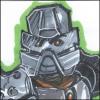
We got on the Interstate and entered the town of Sweetwater, which styles itself as the Wind Energy Capital of the World - and I certainly believe it. We got gas at around 12:30 and got drinks before hitting the road again, traveling on the Interstate for about ten miles before exiting on Texas Route 70, which we went on for a good ways.
That is, until our car decided to overheat.
There were no odd sounds, smells, or sights emerging from the hood, but we diligently pulled over at the first chance we got. My dad and I checked under the hood, where everything seemed nominal, while my mom accessed the owner's manual to check on what our dashboard had told us. We waited for a while with the engine off to let it cool down, which we did for about a half-hour. During this time we assessed the levels of coolant and oil, which were both surprisingly low given their Santa Fe top-off but not enough to account for the engine overheat.
We gingerly turned the car back on and everything sounded alright, so we cautiously rolled down the road for about two miles before the engine heat shot up and the dashboard urgently beeped, telling us to stop the car immediately, so we pulled off on a farm-to-market road and stopped the car. Again we checked under the hood, but everything once again appeared to be normal. We did not want to try going any farther down the road, however, so we contacted OnStar for roadside assistance and proceeded to get in touch with possibly the most incompetent and klutzy person we could get, who clearly read off the screen in front of her without comprehending our situation. Eventually - after a ton of re-explaining and exasperation (especially when she asked if we needed a ride literally right after we'd explained the entire situation using small to medium-sized words) - we got ahold of a towing company who sent out a truck to get us. After this, we cancelled our San Antonio and Austin reservations and booked a room in Abeline.
Then began a long wait wherein we all tried our best to pass the time before a fellow who worked down the street rolled up and pulled off to help us. He knew quite a bit about cars - though he wasn't a mechanic - and tried to rectify the situation by adding some coolant. When that didn't fix it, he called his buddy in to bring in some oil - but even after that fellow showed up the same issue was occurring. After some careful exploring of the under-hood area we discovered a dry-rotted, half-ripped, and rapidly disintegrating belt near the engine area. None of us knew what it was but we theorized that it was likely a fan belt, which would make sense given the overheating. (I don't know about the second fellow, but the first one said that he worked for the county government to maintain the county road system, and that they were in the process of paving the mostly unpaved county roads.)
After those two gentlemen left, we waited around for a little while longer before the tow truck arrived. The car was put up on a bed and secured five different ways before we stuffed ourselves into the tow truck cab that lacked air conditioning. We rolled down the windows, which was fairly unpleasant for me in the back - I didn't have enough room to sit down normally and, to avoid breaking my legs, I had to lean them over halfway onto mom, and with the windows down got a face full of air for a half-hour until it went sightly numb.
The tow truck driver used to be a tank driver in Iraq and was very friendly, but scared us when we were careening down the Interstate at 80 MPH. Near the dealership some crazy guy in a pickup truck pulled out in front of the wrecker and braked trying to instigate a crash. After a reaction by the driver I didn't fully see but I assume to be an obscene gesture and his call to the police to report the fellow as a likely drunk, we pulled into the dealership, where we threw away our incredibly warm sodas and acquired cold water bottles.
We waited in the dealership for a few minutes before they set up a shuttle to the hotel. We got all our necessities (read: meltable stuff) and piled into the shuttle, which was driven by a Korean War veteran originally from Alabama but who had lived in Abeline for nearly his entire life. (He was in Korea not when it started, but when it ended.) He had recommendations for barbecue places in Abeline, as we were unsure how many days we would have to stay here. (As it turns out we'll only be here for a day as they replace the belt and do an oil change.)
After getting to the hotel, we ate there as we had no car. It's probably the best hotel food of the trip - certainly better than the bland brick of a chicken breast in Grand Forks or the burned toast of Idaho Falls fame. We replenished our own coolant by ingesting nearly an entire pitcher of lemonade.
Tomorrow: Shreveport, Louisiana, as we've decided to reroute the trip on Interstates, which are safer if the car has another issue. Once we're back in the south we're back to more densely populated regions. (At least there's sweet tea.)
- Read more...
- 0 comments
- 294 views

